No matter what you sell to the public, people hear about those things in various ways. One of them is referral marketing, otherwise known as word-of-mouth marketing. Here’s an explanation of what it is and why you might want to use it. Then, we’ll look at eight examples and pull the best practices from each one.
In this article
What Is Referral Marketing?
Referral marketing centers on incentivizing current customers to tell their friends about your brand. The idea is that those people’s actions should grow your audience and the number of consumers who are interested in your product.
A single-sided referral marketing campaign rewards only one person for acting. Conversely, a double-sided campaign gives something to both the referring party and the new customer.
What Are the Best Channels for Referral Marketing?
Email is one of the most popular channels marketers use to send referral marketing prompts. Messages often come immediately after a person places an order or otherwise has a direct engagement with the brand. Timing the communications that way ensures a brand has a top-of-mind position, which increases a recipient’s likelihood of taking action.
However, you might explore other referral marketing channels. For example, putting a code at the bottom of a restaurant receipt could encourage a satisfied diner to suggest that a friend check out a new place to eat, too.
Another possibility is to invest in physical advertising. Consider the example where a dog grooming company sends a customer a postcard inviting them to tell a friend about the company and get $15 off the next booking. If the mail arrives about a week after someone’s appointment, the customer has had the chance to enjoy the pleasures of a great-looking, well-groomed dog and is more likely to spread the word to other animal lovers.
Before starting with referral marketing, look at the channels you have used to reach customers in the past. Which got the best results? Digging into that data should give you more confidence when choosing which methods to use. There is no universally “right” channel. The ideal approach is to go with the one that historically seems best positioned to get the outcomes you want. There are also many referral marketing tools that can help you achieve your goals and save some time.
What Are Some of the Benefits of Referral Marketing?
When marketers move forward with referral marketing, they’ll likely save time and money. That’s because current customers can provide a path to new consumers who you may not otherwise have reached.
A 2018 study found that 46% of people consider their relatives as resources when researching products. Similarly, 45% of respondents felt that way about friends. People who are in the market for certain products use various resources to learn about those items. However, because they tend to trust individuals they know more than strangers, referrals from these people could resonate more strongly. Thus, referral marketing could drive your sales and stimulate loyalty.
Another benefit of referral marketing is that it lets you reach customers through channels they know. For example, statistics show 97% of smartphone owners use text messaging regularly. Familiarity is why more retailers have started engaging with customers through that method. Store representatives can check stock levels, offer product recommendations and tell shoppers about current sales. Once a representative builds trust through relevant text messages, they can send another to prompt a person to refer a friend.
Referral marketing can make it easier to find more customers who share or are likely to respond favorably to your company’s values. According to 2020 research, people are four-and-a-half times more likely to recommend brands with strong purposes to others they know. Maybe your company upholds practices to fight climate change or end worker exploitation. Whatever your business stands for, referral marketing could connect you with more people who agree with those principles.
How to Implement Referral Marketing in Your Strategy
Now that you’ve learned the basics of how referral marketing works and why you may want to use it, here are eight tips and examples to steer your efforts:
1. Clarify the Specifics
An excellent way to increase interest in a referral marketing offer or program is to explain what people must do to take advantage of it. Look at the example below from EverlyWell, an at-home health test provider.
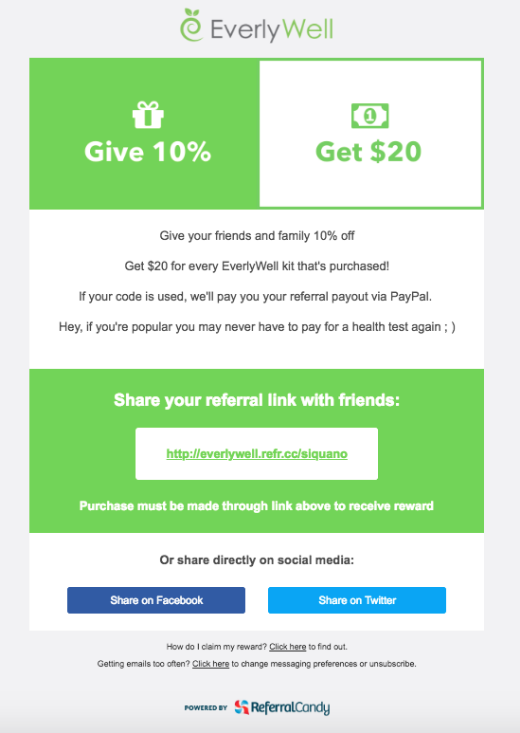
It provides a referral code for customers to pass on to their friends. When someone uses it, the referrer gets $20, and the person using the code enjoys 10% off their purchase. Giving that explanation reinforces the idea that it’s not difficult to participate.
Notice how the example confirms that a referring person will get their payouts via PayPal once someone uses their code. Mentioning that specific note is a smart decision on the company’s behalf. Telling people that detail upfront removes the possibility of confusion or incorrect assumptions.
However, giving people the scoop does not mean you must adopt a formal tone. EverlyWell’s content includes a winking emoticon, following a lighthearted suggestion that if people tell enough friends about the company, they may never pay for another health test.
2. Apply a Seasonal Spin When Appropriate
Whether your referral marketing efforts encompass email, direct mail or some other method, your initial goal is to get someone interested enough to take action. It’s often easier to do that once you convince them you’re offering something relevant. Bombas, a sock company, does that well on a landing page devoted to referral marketing. It capitalizes on the holiday season in several ways.
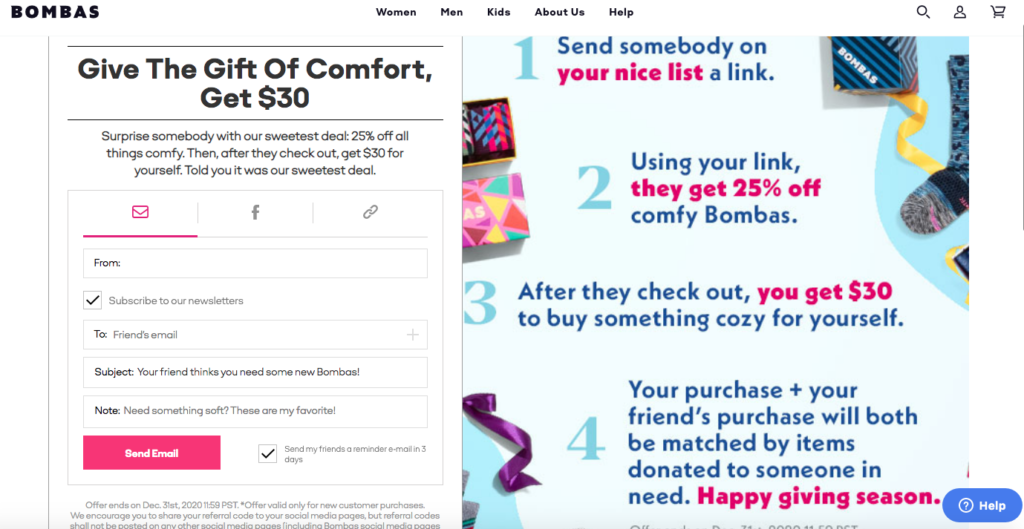
First, it discusses the “nice list,” a common reference to how Santa decides which kids get gifts. Also, the mention of buying something cozy makes sense since people will see this content in the wintertime when it’s more than likely colder than other times of the year.
Finally, the content says Bombas matches both the purchases of a referrer and their friend to give socks to someone in need. It also mentions “giving season.” People show generosity throughout the year, but many feel exceptionally willing to do it during the holiday season while thinking about less-fortunate individuals.
This example also shows how companies can remove the friction that might cause someone to delay or decide against referring someone. A person can distribute their referral method right from the Bombas page. Moreover, they get links to share referral information through social media or anywhere else online. Consider doing something similar so people can tell their friends about your brand in seconds without navigating away from your site.
3. Consider Adding a Contest Element
Sometimes, company representatives decide their referral marketing efforts will work best if they introduce the possibility of getting a nice surprise, along with a guaranteed benefit. Volair, a brand of fitness centers, takes that approach by giving people contest entries for each referral.
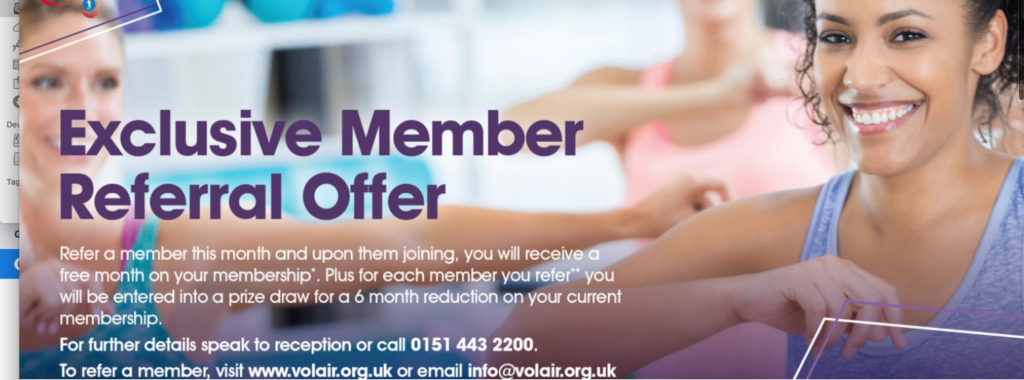
First, if a current member convinces a friend to sign up for a gym membership and have the fee directly taken from their bank account, the referring person receives a free month of gym access. Plus, if the referrer gets up to five people to sign up, they’ll go into a drawing for a chance to win a six-month discount on their membership.
This approach works well because referring individuals get something no matter what. However, the contest aspect also boosts the likelihood that consumers will want to try to recruit several friends instead of just one. Notice the complementing image, too. It highlights the gym as an activity people can do together, encouraging individuals to think about the possibilities.
4. Consider Using a Conversational, Straightforward Approach
Referral marketing done well should build trust between the referrer and company. That’s why you should consider using the same tone a person might adopt if speaking to a best friend when crafting your content. The appropriateness of that option varies depending on your industry, though. In the example below, marketing company SendPulse explains a referral marketing program via a FAQ document.
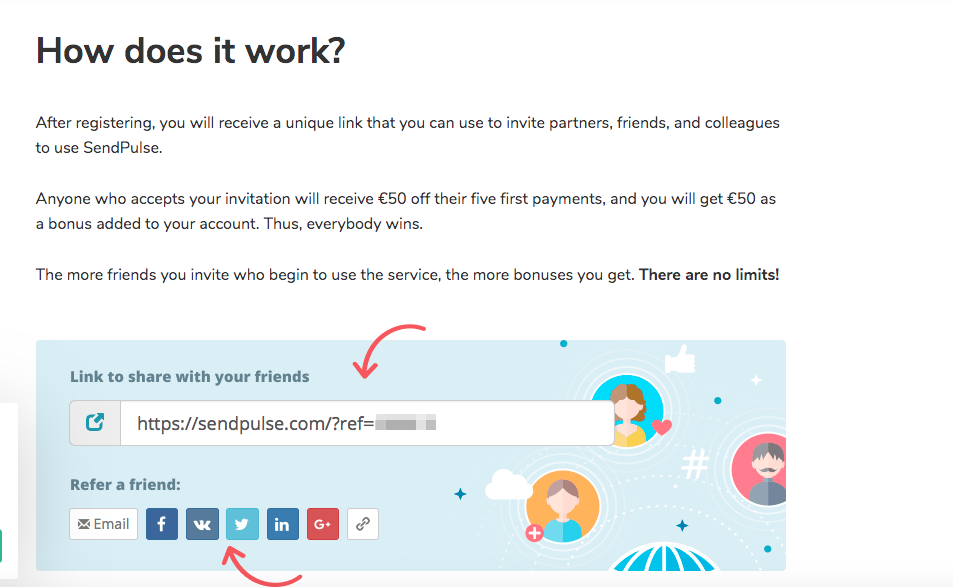
The answer gets to the point and avoids unnecessary words or long paragraphs that could make people disinterested. It also includes red arrows that draw attention to the referral code and the social media links for sharing it.
Another thing the example does well is feature bold font. It emphasizes there are no limits to the number of times people could benefit by referring others to the company.
Think about how you could use some or all of the techniques here to make referral marketing work for you. Remember, you want to show your audience that referring others is not difficult and can bring perks.
5. Add Pictures as Appropriate
The earlier example of enticing people to refer others to a gym presented working out as an activity that could strengthen a friendship, as well as someone’s muscles. Shoe brand Jack Rogers also uses imagery memorably.

The company’s picture choice shows there’s something for everyone, even when shoppers have distinctly different tastes. You only see the people from the calf down, but that’s the perfect perspective, given what the company sells. That angle ensures viewers focus on what matters instead of getting distracted.
The words in this example also have a double meaning. They convey that the brand has footwear a referrer and their friend will love. Plus, both parties benefit from the offer. The person who gets someone they know to buy something while using a referral code receives a $10 discount on their next transaction. Then, the new customer can get the same amount off their first purchase.
Think about what you could do to use text in a similarly creative way. How the marketers used it here made the overall message more impactful.
6. Explore Effective Ways to Catch the Recipient’s Eye
Effective referral methods take people through a multistep process. First, they use something like an email subject line or webpage header to cultivate initial interest. Next, they present an offer so enticing that the reader can’t help but act. Finally, the content includes a call-to-action (CTA). The example below does all three quite well without becoming overwhelming or annoying.
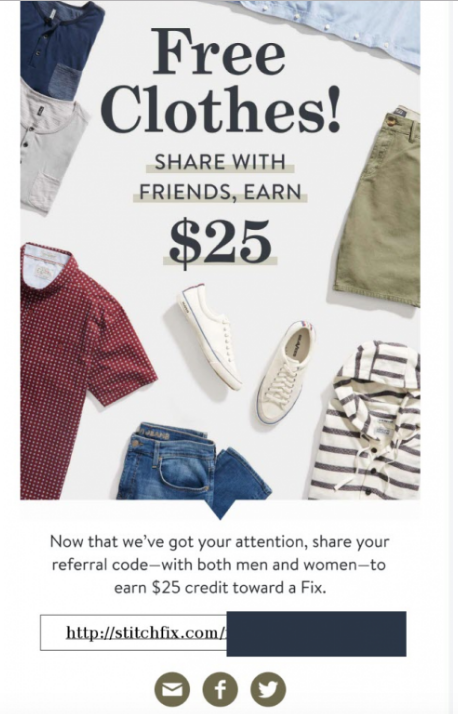
Stitch Fix offers “Free Clothes!” as the attention-grabber. The copy below the header even admits the purpose was to make someone take notice. The all-caps, smaller font explains what someone could get, and the underlined words naturally attract a person’s gaze.
Lastly, the CTA is for someone to share their unique referral code. Since Stitch Fix handily provides social media links underneath the CTA, that technique gently suggests that people could and should start spreading the word on their platforms of choice.
The use of color is also a strategic choice made by company representatives. Check out how the tan hue of the underlined words complements many of the items in the picture. You could also use color to increase the chances of your content standing out from the dozens of other things competing for attention on a typical site.
7. Introduce a Sense of Urgency
Another frequently utilized strategy is to let people know they must act fast to avoid missing out. Study the example below, which is a double-sided referral marketing campaign.
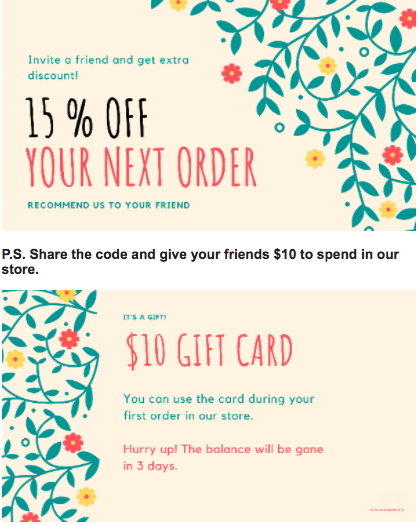
Something it features that the other examples here don’t is a time frame. People have only three days to participate in the offer before it expires. You may wish to use the same tactic, especially if you’re worried about consumers initially getting interested, then forgetting what you’re offering.
Although there may be a company name listed in the small print in the bottom right corner, the example does not have strong branding. That’s not an ideal way to sell your brand. Consider that part of this example as something to avoid in your campaigns.
Bringing urgency into the equation often achieves results, though. If you can get people interested at a time when your brand is already on their minds due to reading a marketing message from you, they’ll be more likely to act immediately. That’s especially true if they want to participate in a time-bound offer.
8. Position the Referrer as Having Valuable Information
You could also highlight how the referrer has information other people would want to know. Their knowledge of the company could assist others. This possibility works especially well for companies that provide services that virtually everyone will need eventually, such as the apparel-cleaning company in the example below.

The messaging urges customers to tell their friends about the company’s delivery service and its physical locations. “We would love to take care of them too,” the text proclaims. Company representatives hope customers are so happy that they’ll gladly suggest the service to their friends.
This approach also gives the impression that the organization trusts its customers to tell others about the brand, assuming they are happy. Consumers often appreciate being put in this position. It enables them to directly support the business’s success by bringing more people to it.
Best Practices for Generating B2B Referrals
Referrals are worth their weight in gold when it comes to B2B lead generation:
- A whopping 92% of people trust referrals from people they know.
- The average conversion rate from B2B sits at an impressive 11% (vs 2.3% in non-referral leads).
- And on average, referrals account for 65% of companies’ new deals.
So, it’s clear to see that referral marketing is a fantastic tool for generating warm B2B leads — but how do you create a strategy around it?
Here’s how:
Make the ask at the right time
Two of the biggest mistakes today’s B2B businesses make is not asking for referrals at all or asking at the wrong time. Or possibly worse, thinking that there is one ‘right-time-fits-all’ answer.
The answer to the question “What’s the right time to ask for a referral?” is, whenever it’s most convenient for your customer! More often than not, this is after the customer has been on-boarded and happy with your product or service for a certain period of time.
Remember, referrers want to protect their reputation in recommending your company to their contacts. So, one of the best times to ask for a referral is after a customer has benefited from your product or service in some way.
It’s also important to make it extremely simple for the referrer to make their referral. Ensure they have any materials or information they need to pass along. And be available for any questions that might arise.
Incent Customers (and Especially Repeat Refers)
Once you begin asking customers for referrals, you may find that some of them are more than willing— even enthusiastic— about sending them your way.
Many customers will make referrals on your company’s behalf simply because they enjoy using your product or service. And that’s great! However, you should still thank (and reward) them for doing so.
Incenting referrals can be a bit tricky. You need to make sure that you’re not just asking for any lead, but for qualified leads. The incentive is really going to be unique to your company, but some of the most popular include things like:
- Monetary incentives
- A discount on the referrer’s plan for each qualified lead they send
- Free ‘extras’ for the referrer
- A discount for both the referrer and the referred
- Extra entries in a contest or drawing from your company
Again, it’ll be up to your team to create an incentive that’s valuable to your referrer.
Incent your Team
Just as you incent customers to provide referrals, you should incent your team to ask for them.
If you are serious about increasing the number of referral leads for your business, your team should be both trained on how to ask for them— and motivated to do so.
Salespeople who get and close referral leads could also be rewarded with an extra bonus. Or they could get a higher commission on referral sales.
Putting some type of reward in place for your sales team for securing referrals will help remind them to ask their best clients and customers when the time is right.
Find Affiliates
One way to get referral leads without asking your current customers is to start an affiliate program.
Affiliate programs are a type of ‘performance-based’ selling in which a business rewards one or more affiliates (normally a blogger or online influencer). For each visitor or customer brought by the affiliate’s own marketing efforts, they normally receive some sort of commission.
For example, let’s say you own a staffing company. You get in touch with a blogger who is very popular in the recruitment and staffing niche, and whose readers closely match your target audience. The blogger then recommends your staffing company in a few of their blogs. For every lead that comes from that blog, your affiliate would earn a commission.
Affiliate programs are extremely attractive to B2B companies due to the low set-up cost and almost guaranteed ROI. Plus, they work—more than half of the consumers say they trust the reviews they read online as much as personal recommendations.
Choose a B2B Lead Generation Partner
Put quite simply—the more customers you have, the more referrals you can garner. Bringing in a lead generation partner will really help you scale your customer base so you can then ramp up with referrals.
Prospecting tools, cold-calling services and B2B lead generation services help you increase your reach beyond the capacity and bandwidth of your team. Not only that, but they can also prospect and pre-qualify leads to ensure your salespeople can focus solely on closing and nurturing them.
This leads to an overall more pleasant experience for your team, and for your customer. And, in turn, this creates a higher likelihood of more referrals!
Of course, no matter how many customers or referrals you have, growth will come slowly if you’re not focused on efficiency.
Put Referral Marketing to Work for You
Referral marketing helps your company gain momentum by depending on people who are already familiar with and pleased with your business. Besides trying these eight tips, consider tracking metrics to determine which referral marketing techniques are most effective for reaching your goals.



